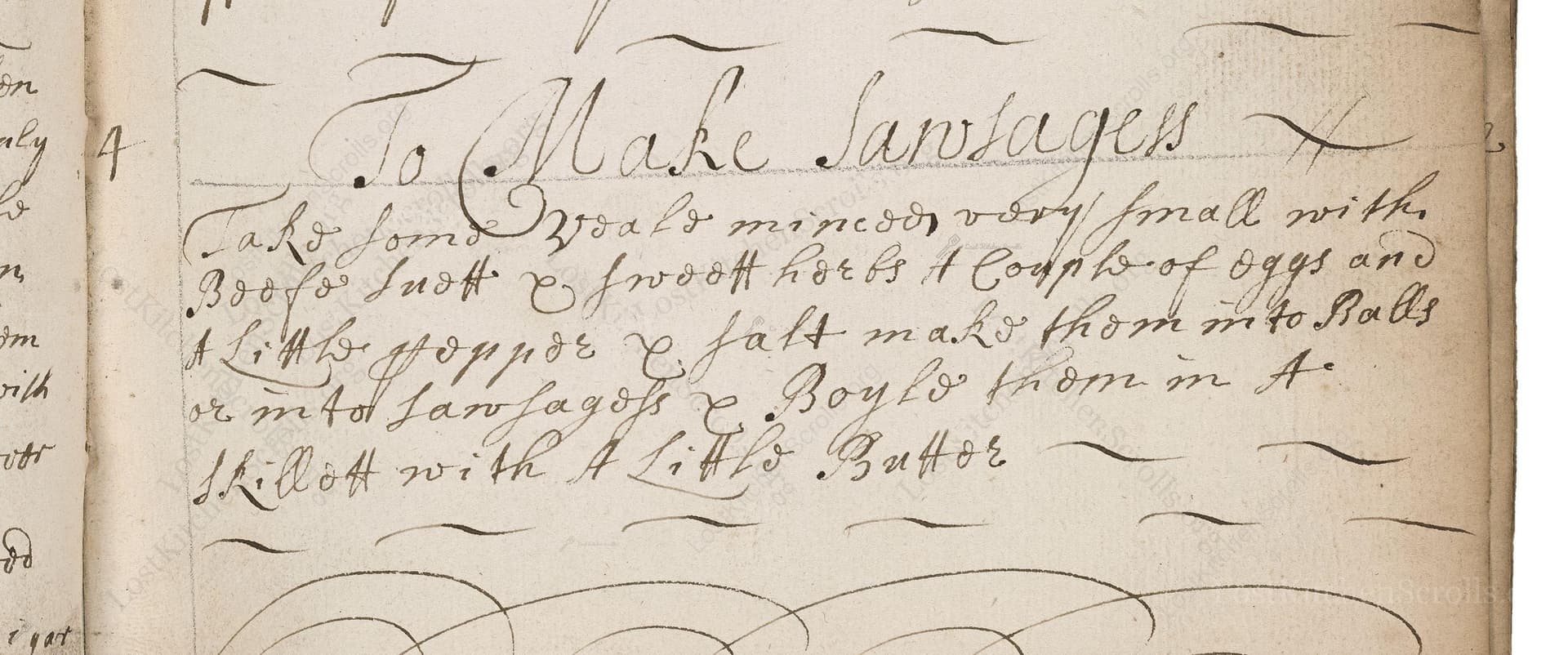To Make Savsages
From the treasured pages of Cookbook of Ann Smith, Reading
Written by Ann Smith

To Make Savsages
"Take fome veals minc'd vory Small with Beefo Suett & sweet herbs & A Couple of Eggs and A little pepper & salt make them into Balls or into favfages & Boyled them in A Skillet with A Little Butter"
Note on the Original Text
Like many recipes of the 17th century, this one uses brief and informal instructions: quantities are vague ('a little,' 'a couple'), and the order of operations is implied, not explicit. Words such as 'favfages' and 'Boyled' reflect period spelling, where 's' may appear as 'f' (a long s) and spellings varied regionally. The recipe relies on assumed kitchen knowledge and experience—no detailed times, temperatures, or measurements—common for manuscript cookery collections of the era. Eggs act as binding, and 'sweet herbs' refer to whatever fresh herbs the household had to hand.

Title
Cookbook of Ann Smith, Reading (1698)
You can also click the book image above to peruse the original tome
Writer
Ann Smith
Era
1698
Publisher
Unknown
Background
Step into the sumptuous kitchens of 17th-century England with Ann Smith’s culinary treasury, where traditional recipes and time-honored techniques invite you to savor the flavors of history. Each page promises a feast of inspiration and a glimpse into the artful dining of a bygone era.
Kindly made available by
Folger Shakespeare Library
This recipe is from Ann Smith, dated 1698, a time when English country households made sausages at home for family meals. The dish reflects the practical, frugal use of veal and suet—ingredients that were readily available and inexpensive for many rural households of the period. Flavorings are kept simple, relying on garden herbs, salt, and pepper, suggesting a rustic approach. Eggs act as the binder, a typical technique before the commercial production of casings and standard sausage-making equipment. Boiling in butter rather than roasting or frying indicates a gentler cooking style that likely resulted in a tender, moist sausage. This method also reflects the limited access to more refined kitchen equipment or larger ovens outside wealthier homes, emphasizing resourceful home cookery.

To make these sausages in 1698, the cook would use a large chopping knife and board or a mincing bowl for the veal and suet, a mixing bowl (often wooden), and her hands for forming the balls or sausage shapes. A skillet—usually cast iron or heavy copper—would be placed over an open hearth or on a trivet above the coals. Butter would be ladled in, and the sausages boiled gently in the fat, with regular turning using wooden spoons or tongs. No meat grinder, sausage stuffer, or modern kitchen gadgets were involved—just skill and elbow grease.
Prep Time
15 mins
Cook Time
12 mins
Servings
4
We've done our best to adapt this historical recipe for modern kitchens, but some details may still need refinement. We warmly welcome feedback from fellow cooks and culinary historians — your insights support the entire community!
Ingredients
- 1 lb 2 oz veal, finely minced
- 3.5 oz beef suet (substitute: grated beef fat or unsalted butter if suet unavailable)
- 1/3 oz mixed sweet herbs (parsley, marjoram, thyme, or similar), finely chopped
- 2 eggs
- Salt, to taste (approx. 1 tsp)
- Ground black pepper, to taste (approx. 1/2 tsp)
- 1 oz butter (for boiling/simmering)
Instructions
- To prepare these historical sausages, begin by finely mincing 1 lb 2 oz of veal and 3.5 oz of beef suet.
- Chop a small handful (about 1/3 oz) of mixed sweet herbs such as parsley, marjoram, or thyme.
- In a bowl, mix the veal, suet, herbs, 2 eggs, and a generous pinch each of salt and ground black pepper.
- Shape the mixture into small balls or sausage-like forms by hand.
- In a large skillet, melt 1 oz of butter over medium heat, then gently place the sausages in the skillet.
- Cook by simmering (not frying) them in the butter, turning occasionally, until the sausages are firm and cooked through, about 10–12 minutes.
Estimated Calories
340 per serving
Cooking Estimates
Preparing the veal and suet, chopping herbs, and mixing the ingredients takes about 15 minutes. Cooking the sausages in butter until firm and cooked through takes about 12 minutes. One serving contains about 340 calories. This recipe makes 4 servings.
As noted above, we have made our best effort to translate and adapt this historical recipe for modern kitchens, taking into account ingredients nowadays, cooking techniques, measurements, and so on. However, historical recipes often contain assumptions that require interpretation.
We'd love for anyone to help improve these adaptations. Community contributions are highly welcome. If you have suggestions, corrections, or cooking tips based on your experience with this recipe, please share them below.
Join the Discussion
Rate This Recipe
Dietary Preference
Main Ingredients
Culinary Technique
Occasions

Den Bockfisch In Einer Fleisch Suppen Zu Kochen
This recipe hails from a German manuscript cookbook compiled in 1696, a time whe...

Die Grieß Nudlen Zumachen
This recipe comes from a rather mysterious manuscript cookbook, penned anonymous...

Ein Boudain
This recipe comes from an anonymous German-language manuscript cookbook from 169...

Ein Gesaltzen Citroni
This recipe, dating from 1696, comes from an extensive anonymous German cookbook...
Browse our complete collection of time-honored recipes



